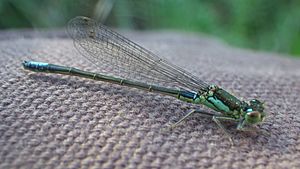San Francisco forktail facts for kids
Quick facts for kids San Francisco forktail |
|
|---|---|
 |
|
| Conservation status | |
| Scientific classification | |
| Kingdom: | |
| Phylum: | |
| Class: | |
| Order: | |
| Suborder: | |
| Family: | |
| Genus: | |
| Species: |
I. gemina
|
| Binomial name | |
| Ischnura gemina (Kennedy, 1917)
|
|
| Synonyms | |
|
Celaenura gemina Kennedy, 1917 |
|
The San Francisco forktail (Ischnura gemina) is a small, special type of damselfly. It belongs to the family Coenagrionidae. This damselfly is found only in the San Francisco Bay Area in California, United States. This means it is endemic to that area.
It is a very rare insect. Its home area is smaller than 500 square miles. You can find it only in the greater San Francisco area and parts of San Mateo and Marin Counties. Experts say this damselfly is "one of the rarest Odonates" (which are dragonflies and damselflies) in the United States.
About the San Francisco Forktail Damselfly
This damselfly is quite small. It grows to be about 2.5 centimeters long. That's about the length of your thumb!
What Does the San Francisco Forktail Look Like?
The male damselfly is mostly black. It has cool blue colors on the sides of its body, near its wings. It also has blue dots closer to the end of its tail-like body part. The female damselfly looks a bit different. She has a dull green color on the sides of her body.
This damselfly looks a lot like another species called Ischnura denticollis. You can tell them apart by looking closely at the male's body parts used for mating. Sometimes, these two different damselfly species can even mix and have babies together.
How Long Do San Francisco Forktails Live?
These damselflies are active for many months. You can see them flying around from March all the way to November. Adult damselflies can live for over 30 days. This is actually a pretty long life for a damselfly!
Where Do San Francisco Forktails Live?
This species lives in areas near the coast of the Bay Area. Scientists think their long lives and long flying season help them survive in the foggy weather common in that region. This is an adaptation, meaning they have developed ways to fit into their environment.
The San Francisco forktail naturally lives in different wetland areas. These include wet spots where water seeps out of the ground and small ponds. They can even handle some changes to their homes, like when waterways are straightened. But they need to have marshy plants nearby to survive.
What Do San Francisco Forktails Eat?
The baby damselflies, called larvae, grow up hidden among water plants. The adult damselflies fly around and eat other small bugs that live in wetland areas.
Protecting the San Francisco Forktail
Sadly, the number of San Francisco forktail damselflies has gone down a lot. This is because their homes have been destroyed or damaged. The Bay Area is a very busy place with many cities.
Why Are San Francisco Forktails Disappearing?
For example, these damselflies used to live in a wetland in Glen Canyon Park in San Francisco. But these wet spots became too separated from each other. This made it hard for the damselflies to live there. After some parts of the park's wetlands were fixed up, people tried to bring the damselflies back. They lived there for a short time but then disappeared again. Even though this try didn't work out, it helped scientists learn what kind of home these insects really need.
What Is Being Done to Help?
Because it has such a small home range and small populations, this damselfly was once listed as an endangered species by the IUCN Red List. This list helps track animals and plants that are at risk.
Now, its status has been changed to vulnerable. This is still a serious concern, but it's a bit better than endangered. This change happened because more damselflies have been found in a few new places. Also, they can fly fairly far to find new homes. Plus, they are somewhat able to handle some kinds of pollution that harm their homes.


